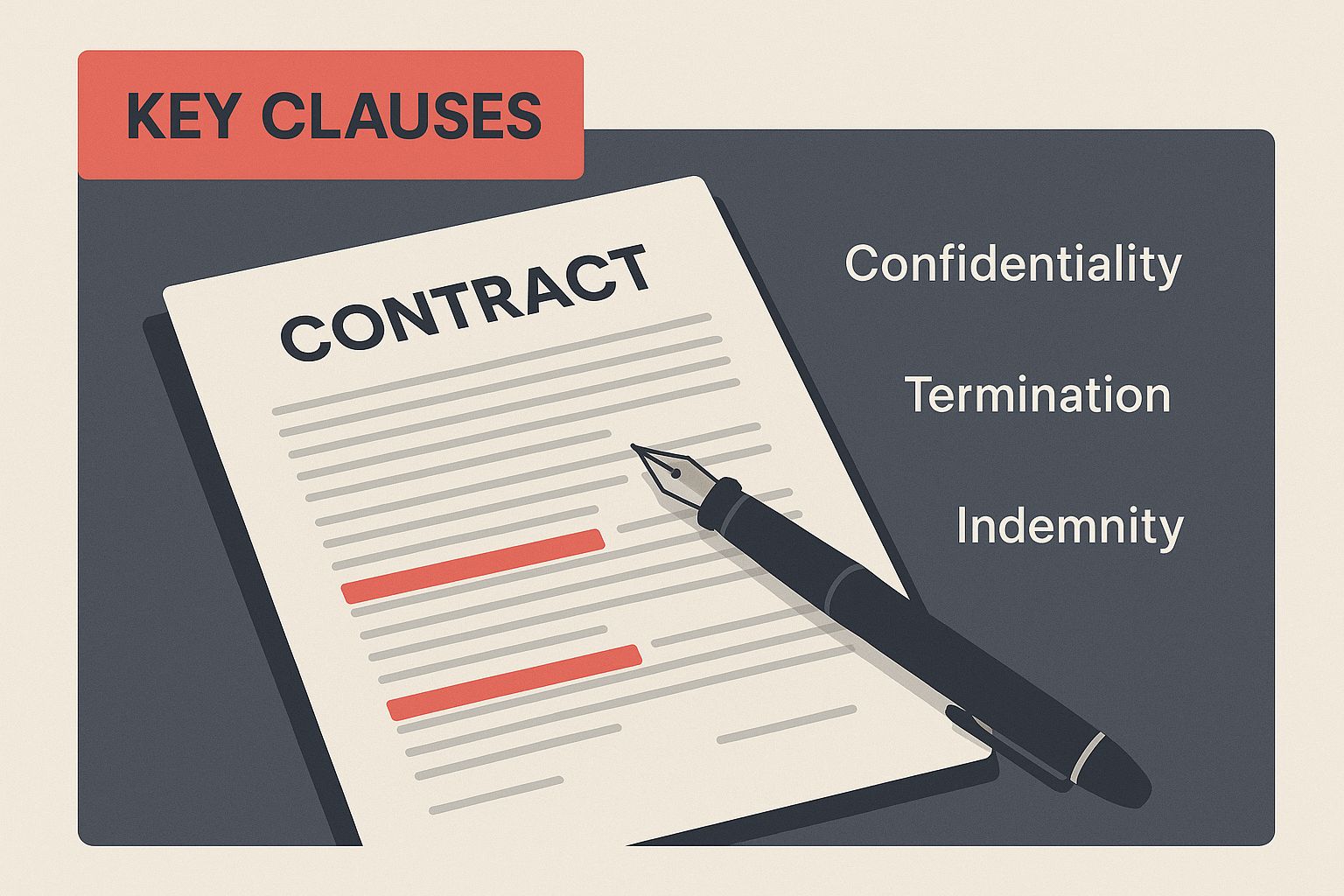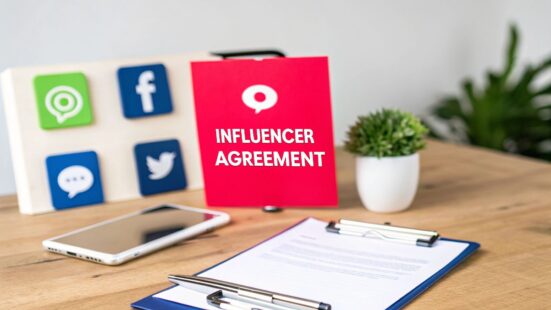 How to Monetize Mobile Apps for Maximum Revenue
How to Monetize Mobile Apps for Maximum Revenue
An influencer marketing agreement is a legally binding contract that lays out the entire scope of a partnership between a brand and a creator. It defines everything from deliverables and compensation to content ownership and disclosure requirements, acting as a strategic blueprint for a successful collaboration.
Table of Contents
What an Influencer Marketing Agreement Actually Does

Think of an influencer agreement less like a rigid legal hurdle and more like the "rules of the road" for your campaign. It's the document that elevates a casual handshake deal or a string of DMs into a professional, legally protected partnership. It’s all about making sure both you and the influencer are on the exact same page from day one.
Without this foundational document, you’re basically inviting trouble. Key details are left open to interpretation, which is a recipe for miscommunication, missed deadlines, or a campaign that just falls flat. A strong agreement is your best defense against ambiguity.
Building a Foundation of Trust and Clarity
At its core, an influencer agreement is about creating a shared understanding. It meticulously details every single piece of the collaboration, leaving absolutely no room for assumptions. When everything is in writing, you establish a baseline of trust and transparency right from the start.
To help you get started, here's a quick look at the core components of any solid agreement and why they are absolutely essential.
Essential Pillars of an Influencer Agreement
| Component | Why It Matters |
|---|---|
| Deliverables & Deadlines | Spells out exactly what the influencer will create (e.g., three Instagram Reels, one YouTube video) and when it's due. No guesswork involved. |
| Compensation | Defines the payment amount, schedule, and method. This ensures the creator is paid fairly and on time, which is critical for a good relationship. |
| Content Usage Rights | Secures your ability to repurpose the influencer's content on your own channels, maximizing the return on your investment. |
| FTC Disclosures & Legal | Includes clauses addressing legal must-haves, like FTC disclosures, protecting both of you from potential compliance headaches down the line. |
Each of these pillars works together to create a stable framework for the partnership, ensuring a smooth and productive collaboration.
A Roadmap for a Successful Partnership
Ultimately, an influencer marketing agreement is more than just a contract; it's a strategic tool. It formalizes your collaboration in an industry that's projected to hit a global market size of $32.55 billion. With over 80% of marketers globally confirming influencer marketing is a highly effective strategy, the need for professional documentation has never been more critical. You can read more about the latest influencer marketing trends to see why this is so important.
A well-crafted agreement doesn't just prevent problems—it actively sets the stage for success. It aligns goals, manages expectations, and fosters a respectful, professional relationship that can lead to powerful, long-term partnerships.
By taking the time to create a thorough agreement, you aren't just covering your legal bases. You're building a framework that allows creativity to flourish within clear boundaries, making sure the campaign runs smoothly and hits its targets. It’s arguably the single most important step you can take to launch a successful influencer campaign.
Breaking Down the Core Contract Clauses
Think of your influencer marketing agreement as the blueprint for a custom-built house. Just winging it might get you four walls and a roof, but the final result will be shaky and probably not what you wanted. The core clauses are your detailed instructions, ensuring every single part of the collaboration is built to spec.
These clauses are the heart of the deal, turning vague chats and DMs into solid, legally-binding terms. Without them, you're just running on assumptions and hoping for the best—a recipe for disaster in any business partnership. Let’s pull apart the most critical pieces that make up a rock-solid agreement.
This infographic breaks down the essential clauses that form the foundation of any good influencer marketing agreement.

As you can see, the real strength of a contract comes from how these clauses work together, starting with an ultra-clear Scope of Work.
Define the Scope of Work with Precision
The Scope of Work (SOW) is, without a doubt, the most important part of your entire agreement. This is where you kill ambiguity. Vague instructions like "promote our new skincare line" are useless and invite disappointment.
You have to get granular. Your SOW should be a checklist, not a suggestion.
- Content Formats: What exactly are they making? (e.g., one Instagram Reel, one 5-image carousel post, three Instagram Stories).
- Quantity of Deliverables: How many of each format? (e.g., "three (3) TikTok videos and one (1) dedicated YouTube short").
- Key Deadlines: When is everything due? Lock in dates for first drafts, your feedback, and the final go-live posts to keep the campaign humming along.
By defining the SOW with this level of detail, you create a clear roadmap for success. The influencer knows precisely what to deliver, and you have a concrete yardstick to measure the project against.
While the contract handles the legal stuff, you'll still need to provide creative direction separately. A great way to do this is with a comprehensive influencer brief template, which you can use to align on the creative vision long before a contract is even signed.
Clarify Content Ownership and Usage Rights
So, the content is live. Now what? Who owns it, and what can your brand actually do with it? This is where ownership and usage rights come in, and getting this wrong can be a very expensive mistake.
Here’s the typical setup: the creator retains the copyright (the legal ownership) of the content. What your brand is actually getting is the usage rights—basically, a license to use that content in specific ways.
Think of it like leasing a car. You don't own it, but you have the right to drive it based on your lease terms. Your contract needs to spell out those terms:
- Where you can use the content: List the exact platforms (e.g., your brand’s Instagram feed, paid Facebook ads, email newsletters, website homepage).
- How long you can use it: Define the license duration (e.g., "for 12 months from the initial post date").
- Whether you have exclusive rights: Can the influencer sell or reuse this content for another brand deal?
If you don't nail this down, you could end up paying for incredible content that you have no legal right to repurpose on your own marketing channels.
Outline Compensation and Payment Terms
Let's talk about money. Clear and transparent payment terms are all about building trust and professionalism. This clause should leave absolutely no doubt about how, when, and how much the influencer gets paid, all tied directly to the deliverables in the SOW.
Beyond the total fee, you need to lock in the specifics:
- Payment Structure: Is it a simple flat fee? Performance-based? Or a hybrid of both?
- Payment Schedule: Spell out the milestones. A common approach is 50% upfront to kick things off and 50% upon campaign completion. Or maybe you operate on Net-30 terms after the final post goes live.
- Payment Method: How are you sending the money? (e.g., direct bank transfer, PayPal, Wise).
Getting this all in writing prevents awkward back-and-forths and potential disputes down the road.
Include Exclusivity and Conflict of Interest Clauses
An exclusivity clause is your brand's shield. It prevents an influencer from turning around and working with your direct competitors for a set period. This is crucial for protecting your campaign’s impact and making sure your message doesn't get muddled.
For instance, if you're a coffee brand, the last thing you want is your influencer promoting a rival's cold brew the very next week. Your clause needs to define:
- Who counts as a competitor: Be specific. You can list categories (e.g., "any other direct-to-consumer coffee brand") or even name specific companies.
- The duration of the exclusivity period: This usually covers the campaign's active dates plus a buffer afterward (e.g., 30 days post-campaign).
If you want to get a better feel for how these foundational legal clauses are structured, it can be helpful to review some general terms of service documents. They offer great insight into the standard language and provisions that form the backbone of many legally binding agreements. Together, these clauses create a secure, transparent, and successful partnership.
Navigating Compliance and Legal Requirements
Beyond the fun stuff like deliverables and payment, a solid influencer agreement is your legal shield. This is the part of the contract that plays defense, anticipating everything from regulatory headaches to messy disputes. It puts clear guardrails in place to protect both you and the creator.
Think of these clauses less like boring legal formalities and more like the essential safety features of your campaign. Without them, you’re leaving your brand wide open to legal risks, reputation damage, and serious financial trouble. One little compliance slip-up can torpedo an otherwise amazing partnership, making this section absolutely critical.
Mastering FTC Disclosure Guidelines
Let’s be clear: transparency isn't just a nice-to-have, it's the law. The Federal Trade Commission (FTC) mandates that any "material connection" between a brand and an influencer must be disclosed clearly and conspicuously. This is a non-negotiable, and your agreement has to spell out that the influencer is responsible for following these rules to the letter.
Your contract needs to be crystal clear about the how. Ambiguity is your worst enemy here.
- Required Hashtags: Make sure they use obvious tags like #ad or #sponsored right at the beginning of the caption. Burying it in a messy pile of other hashtags at the end won’t cut it.
- Platform-Specific Tools: Insist they use the built-in features, like Instagram's "Paid Partnership" label or TikTok's branded content toggle. These add another layer of visible, compliant disclosure.
If an influencer fails to disclose your partnership properly, it's not just their problem—it puts your brand squarely in the FTC's crosshairs. Your agreement is the first line of defense, proving you made compliance a mandatory condition of the deal.
For a deeper dive, check out our complete guide to FTC guidelines for influencers. It breaks down the actionable steps for both brands and creators.
Protecting Brand Secrets with Confidentiality
Picture this: your influencer gets excited and accidentally leaks details about your new product a week before launch. A confidentiality clause—often called a Non-Disclosure Agreement (NDA)—is designed to stop that exact nightmare from happening. It legally binds the influencer to keep any sensitive information they learn during the collaboration under wraps.
This is especially vital when you're sharing:
- Unreleased products or services
- Confidential marketing plans
- Internal sales data or campaign results
The agreement needs to define what counts as "confidential information" and make it clear that this obligation doesn't end when the campaign does.
Shielding Your Brand with Indemnification
An indemnification clause is basically a "hold harmless" agreement. It’s your safety net. This clause protects your brand from legal claims that pop up because of the influencer's content or actions.
For instance, if an influencer uses copyrighted music in their video without a license or makes a false claim about your product, this clause shifts the legal and financial responsibility to them. If your brand gets sued over something they did, they are contractually on the hook for the legal costs and any damages.
Planning for the Unexpected with a Termination Clause
Let's face it, not every partnership is a perfect match. A clear termination clause outlines exactly how either party can walk away professionally if things go south. It’s a clean exit strategy that prevents a bad situation from getting worse.
Common reasons for termination include:
- Breach of Contract: They miss deadlines or fail to deliver the content as promised.
- Morality Clause Violation: The influencer does something that could seriously tarnish your brand's reputation.
- Mutual Agreement: Sometimes, both sides just agree it's time to part ways.
This clause should also detail what happens next—like returning products and settling up payment for work that was completed. And remember, navigating the legal landscape also means sticking to strict data privacy guidelines, which is a whole other layer of compliance.
The rules for influencer marketing are always changing. Just recently, Italy’s Communication Regulatory Authority (AGCOM) rolled out a new framework forcing influencers to be much more explicit with ad disclosures. This global push for stricter regulation just highlights why having a detailed influencer marketing agreement is more important than ever.
Defining Success With Performance Metrics
An influencer agreement is more than just a to-do list for the creator. It needs to clearly define what a "win" actually looks like for your campaign. Ditching the old "post and pray" method means embedding specific, measurable Key Performance Indicators (KPIs) directly into the contract. This simple step turns your agreement from a basic task list into a powerful tool for accountability.
Without clear metrics, you're flying blind. You have no objective way to know if a campaign actually worked. It’s like building a car without a speedometer—you know you're moving, but you have no idea how fast you're going or if you'll ever reach your destination. Solid KPIs get both you and the influencer aiming for the exact same target.
Setting Realistic Goals And KPIs
First things first: you need to decide which metrics actually matter for your specific goals. Are you trying to build brand awareness? Drive traffic to your website? Or generate direct sales? Each of these goals relies on a completely different set of KPIs.
For instance, a brand awareness campaign would lean heavily on metrics like reach and impressions. But a sales-focused campaign will zoom in on conversion rates and clicks. Your influencer agreement has to spell out exactly which metrics you'll be tracking.
Some of the most common KPIs to include are:
- Engagement Rate: This is the big one. It covers likes, comments, shares, and saves, usually calculated as a percentage of the influencer's total followers. It’s the clearest sign of how connected an audience is to the content.
- Reach and Impressions: This tells you how many unique people saw the content (reach) and the total number of times it was viewed (impressions).
- Click-Through Rate (CTR): This measures how many people clicked a specific link in a bio or story. It’s non-negotiable for any campaign meant to drive traffic.
- Conversions: For sales campaigns, this is the ultimate goal. It tracks how many followers took a specific action, like making a purchase with a unique discount code.
If you really want to get into the weeds of tracking financial success, our guide on how to measure influencer marketing ROI offers a complete framework.
Setting realistic goals for these KPIs is just as important as defining them. Engagement rates, for example, can differ dramatically based on an influencer's size.
Typical Engagement Rates by Influencer Tier
To help you set achievable targets in your agreements, here’s a quick look at what you can generally expect from different tiers of influencers. As you can see, smaller audiences often pack a bigger punch in terms of engagement.
| Influencer Tier | Follower Range | Average Engagement Rate |
|---|---|---|
| Nano-Influencer | 1K – 10K | ~4.7% |
| Micro-Influencer | 10K – 100K | ~1.7% |
| Mid-Tier Influencer | 100K – 500K | ~1.4% |
| Macro-Influencer | 500K – 1M | ~1.3% |
| Mega-Influencer | 1M+ | ~1.1% |
Keep these benchmarks in mind when you're negotiating terms. Promising a macro-influencer a massive bonus for a 5% engagement rate might be setting everyone up for disappointment.
Tying Performance To Compensation
One of the smartest ways to get everyone on the same page is to build performance-based incentives right into the payment structure. This gives creators a real reason to produce killer content that drives results, maximizing your return. It creates a true partnership where everyone wins when the campaign succeeds.
A performance-based model shifts the dynamic from a simple transaction to a true collaboration. The influencer becomes a stakeholder in the campaign's success, incentivized to go the extra mile to drive real results for your brand.
You can structure this in a few different ways:
- Base Fee + Bonus: Offer a flat fee for the deliverables, plus an extra bonus if the content hits a specific target, like exceeding 10,000 likes or generating 500 link clicks.
- Tiered Bonuses: Set up multiple bonus levels to keep the motivation high. For example, a $200 bonus for 50 sales, a $500 bonus for 100 sales, and so on.
- Affiliate Model: This is a pure performance play. You offer a percentage of every sale made through the influencer’s unique tracking link or promo code.
Getting these terms into the influencer marketing agreement is crucial. According to industry research, 32% of marketers say that measuring creator performance is one of their biggest headaches. This is exactly why detailed performance clauses are a must-have. Data shows that nano-influencers often pull in the highest engagement rates at 2.71%, a fact that should absolutely inform your expectations and compensation models. You can discover more insights about these influencer marketing statistics on Backlinko.com to build a smarter, more effective strategy. This data-driven approach ensures your contract is built on solid ground with a clear road map to success.
Common Pitfalls and How to Avoid Them

Putting together an influencer agreement is a massive step toward a great campaign, but even the tightest plans can hit a snag. A few common, seemingly tiny mistakes can balloon into major headaches, from blown deadlines to ugly legal disputes. But here's the good news: learning from these frequent missteps is the key to creating a truly bulletproof contract.
Think of it as learning a road’s most dangerous curves before you start driving. When you know where others have slipped up, you can navigate your partnership with total confidence, ensuring a smooth ride from start to finish. This is your practical guide to spotting and fixing these issues before they ever become problems.
Each pitfall is a potential crack in your campaign's foundation. Luckily, every single one has a straightforward fix that you can build right into your agreement. Let's break down the most common errors and how to get ahead of them.
Pitfall 1: Vague Deliverable Descriptions
One of the fastest ways to derail a campaign is with a fuzzy Scope of Work. Instructions like "a few posts about our new product" are a recipe for disappointment. The influencer might think that means one quick Reel, while you were expecting a multi-post carousel and three separate Stories.
This kind of ambiguity creates a mismatch in expectations that can instantly sour the relationship and tank your results. It’s a classic case of assuming everyone is on the same page when you’re actually reading from completely different books.
The Solution:
Be relentlessly specific. Your agreement should read like a precise checklist, not a casual suggestion.
- Wrong: "One video for TikTok."
- Right: "One (1) 45-60 second TikTok video featuring the product in use, including a link to the product in the creator's bio for 24 hours."
This level of detail eliminates all the guesswork. The influencer knows exactly what to create, and you know exactly what you’re paying for.
Pitfall 2: Unclear Content Usage Rights
Imagine this: you pay for stunning content, only to discover you can't use it in your paid social ads or on your website. This happens way more often than you'd think when usage rights aren't clearly defined. By default, the creator owns the copyright to their work; you are simply licensing it.
Without an explicit clause, you could be legally barred from repurposing the very assets you funded. This move severely limits your campaign’s ROI and can lead to expensive legal battles if you use the content without permission.
The Solution:
Your influencer marketing agreement must contain a detailed usage rights clause. Spell out exactly how, where, and for how long you can use the content.
- Platforms: "Brand is granted rights to use the content on its organic social media channels (Instagram, Facebook, TikTok) and in paid digital ads on Meta platforms."
- Duration: "This license is valid for a period of 12 months from the date the content is first published by the Influencer."
- Exclusivity: "Brand has exclusive rights to use the content for the duration of the license period."
Pitfall 3: Neglecting the Morality Clause
An influencer acts as a representative of your brand, even if it's just for a short time. If they get tangled up in a public controversy, that negative backlash can easily splash onto your company. A morality clause is your brand's safety net against this kind of reputational damage.
This clause gives you the right to terminate the agreement and distance your brand if the influencer engages in behavior that contradicts your brand values or brings them into public disrepute. In an age where online reputation is everything, it's a critical tool for managing risk.
The Solution:
Include a clear, professionally worded morality clause that outlines the conditions for ending the partnership. It should cover things like unlawful behavior, hate speech, or any public conduct that could tarnish your brand’s image, giving you a clean and immediate exit strategy if you ever need one.
Finalizing Your Agreement for a Strong Partnership
Getting to the signature line on your influencer marketing agreement isn't the end of the road—it’s the starting block for a great partnership. This document is way more than a list of tasks; it’s what sets the professional tone for everything that follows. Treating this final step with care is your best bet for building a relationship that runs on mutual respect and total clarity.
The negotiation process shouldn't feel like you're going into battle. Think of it as a collaborative chat where both you and the influencer can ask questions, get clear on the terms, and feel genuinely heard. An open, honest conversation at this point stops tiny misunderstandings from blowing up into major headaches down the line.
Fostering a Collaborative Negotiation
The real goal here is to land on an agreement that feels fair to everyone. A contract that’s totally one-sided can create resentment, and that’s the last thing you want when creativity and authenticity are the names of the game. Encourage the influencer to read through everything and speak up about any concerns they might have.
This is your moment to build a rock-solid foundation for the partnership.
- Jump on a Call: A quick video or phone call can clear up questions way faster than a long, drawn-out email chain. It just adds that necessary human touch to a legal process.
- Explain the "Why": If you have clauses that are non-negotiable for your brand, like exclusivity, take a minute to explain the reasoning behind them. A little bit of context can turn a point of friction into a moment of shared understanding.
- Be Open to Small Tweaks: Showing a little flexibility on smaller details, like the timing of payments or the window for content review, proves that you see the influencer as a real partner, not just a vendor.
The Agreement as a Living Document
Once that influencer marketing agreement is signed, don’t just file it away and forget it. It should be your shared roadmap for the entire campaign. It’s the playbook that both your team and the influencer can reference anytime to double-check deliverables, deadlines, and who’s responsible for what.
A well-crafted agreement stops being just a legal shield and becomes a strategic tool. It guides every action, aligns all expectations, and gives you a clear path for handling any issues that pop up, keeping the campaign right on track.
This document truly sets the stage for a professional and successful relationship. It makes sure everyone knows the rules of the game and is pulling in the same direction.
Ultimately, the effort you pour into finalizing your agreement with care and respect is a direct investment in the campaign's success. It lays the groundwork not just for one project, but for powerful, long-term collaborations that can drive serious growth for your brand. A strong start almost always leads to a strong finish.
Frequently Asked Questions
When you're getting into the nitty-gritty of an influencer agreement, a lot of questions pop up. It happens to everyone, especially if you're formalizing these kinds of partnerships for the first time.
Let's walk through some of the most common questions I hear. My goal is to give you clear, straightforward answers so you can build your agreement with total confidence.
Do I Really Need a Contract for a Small Campaign?
Yes. One hundred percent, yes. Even if it's just a gifted collaboration or you're working with a nano-influencer, you absolutely need something in writing. A simple agreement prevents those classic misunderstandings about what you expect in return for your product.
It’s the only way to make sure the influencer knows they need to post, tag your brand correctly, and use the right FTC disclosures. A minor dispute can still cause a headache for your brand's reputation, and a basic contract is your best line of defense, no matter how small the campaign feels.
Think of it this way: a contract isn't just for when things go wrong; it's a tool to make sure things go right. It provides the necessary structure for a smooth and successful collaboration, no matter how small.
What Is the Difference Between Ownership and Usage Rights?
This is a big one, and it trips up a lot of brands. Getting this distinction right is key to getting the most value from your content and staying out of legal hot water.
- Content Ownership: This is the copyright. Plain and simple, whoever creates the content—the influencer—is almost always the legal owner.
- Usage Rights (or Licensing): This is where you come in. Usage rights are the specific permissions you buy from the owner. Your influencer marketing agreement needs to spell out exactly how, where, and for how long you can use their content (e.g., "on Instagram and in email newsletters for one year").
If you don't define usage rights, you could find yourself legally blocked from using the amazing content you just paid for.
How Should We Handle Content Approvals and Revisions?
To avoid the dreaded endless feedback loop, your agreement needs a clause for this. The best approach is to outline a simple, clear workflow that everyone agrees to before any content is even created.
A solid approval process usually looks something like this:
- The influencer submits their draft content by a specific date.
- Your brand gets a set window (like 48 hours) to review it and give feedback.
- The contract specifies how many rounds of edits are included (e.g., "one reasonable round of edits").
Putting this structure in place stops scope creep in its tracks and shows that you respect everyone's time.
Ready to connect with a diverse network of creators and streamline your next campaign? JoinBrands offers the tools you need to find the perfect influencers, manage collaborations, and generate authentic content at scale. Launch your next campaign with JoinBrands today








